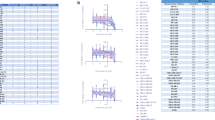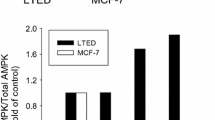Abstract
Previous studies reported that estrogen receptor β (ERβ) is localized to mitochondria, whereas little is known about the physiological functions of mitochondrial ERβ. In the present study, we explored the role of mitochondrial ERβ in regulating apoptosis using stable ERβ-expressing and ERβ knockdown cells lines. We found that exogenous ERβ was mainly expressed in mitochondrial but not in nuclear after ERβ overexpression and protected cells from apoptosis induced by hydrogen peroxide (H2O2), ultraviolet (UV), and staurosporine (STS). Moreover, overexpression of ERβ prevented Bax activation, cytochrome c release, caspase-3 activation, and PARP cleavage during apoptosis. Furthermore, knockdown of ERβ significantly suppressed the expression of ERβ in mitochondrial and promoted cell apoptosis induced by H2O2, UV, and STS. Downregulation of ERβ also enhanced Bax activation, cytochrome c release, caspase-3 activation and PARP cleavage. In addition, our study discovered that mitochondrial ERβ interacted with proapoptotic protein Bad in a ligand-independent manner, which suggests that mitochondrial ERβ inhibits Bad, and prevents Bax activation and cytochrome c release. Collectively, the results of this study support that mitochondrial ERβ prevents cell apoptosis via the mitochondrial apoptotic pathway in a ligand-independent manner.









Similar content being viewed by others
References
Nadal-Serrano M, Sastre-Serra J, Pons DG, Miro AM, Oliver J, Roca P (2012) The ERalpha/ERbeta ratio determines oxidative stress in breast cancer cell lines in response to 17beta-estradiol. J Cell Biochem 113:3178–3185
Thomas C, Gustafsson JA (2011) The different roles of ER subtypes in cancer biology and therapy. Nat Rev Cancer 11:597–608
Mangelsdorf DJ, Thummel C, Beato M, Herrlich P, Schutz G, Umesono K, Blumberg B, Kastner P, Mark M, Chambon P, Evans RM (1995) The nuclear receptor superfamily: the second decade. Cell 83:835–839
Chang EC, Charn TH, Park SH, Helferich WG, Komm B, Katzenellenbogen JA, Katzenellenbogen BS (2008) Estrogen Receptors alpha and beta as determinants of gene expression: influence of ligand, dose, and chromatin binding. Mol Endocrinol 22:1032–1043
Le HH, Belcher SM (2010) Rapid signaling actions of environmental estrogens in developing granule cell neurons are mediated by estrogen receptor ss. Endocrinology 151:5689–5699
Tan XJ, Dai YB, Wu WF, Kim HJ, Barros RP, Richardson TI, Yaden BC, Warner M, McKinzie DL, Krishnan V, Gustafsson JA (2012) Reduction of dendritic spines and elevation of GABAergic signaling in the brains of mice treated with an estrogen receptor beta ligand. Proc Natl Acad Sci USA 109:1708–1712
Ascenzi P, Bocedi A, Marino M (2006) Structure-function relationship of estrogen receptor alpha and beta: impact on human health. Mol Aspects Med 27:299–402
Majidi M, Al-Wadei HA, Takahashi T, Schuller HM (2007) Nongenomic beta estrogen receptors enhance beta1 adrenergic signaling induced by the nicotine-derived carcinogen 4-(methylnitrosamino)-1-(3-pyridyl)-1-butanone in human small airway epithelial cells. Cancer Res 67:6863–6871
Pandini G, Genua M, Frasca F, Squatrito S, Vigneri R, Belfiore A (2007) 17beta-estradiol up-regulates the insulin-like growth factor receptor through a nongenotropic pathway in prostate cancer cells. Cancer Res 67:8932–8941
Cowley SM, Hoare S, Mosselman S, Parker MG (1997) Estrogen receptors alpha and beta form heterodimers on DNA. J Biol Chem 272:19858–19862
Curtis HS, Couse JF, Korach KS (2000) Estrogen receptor transcription and transactivation: estrogen receptor knockout mice: what their phenotypes reveal about mechanisms of estrogen action. Breast Cancer Res 2:345–352
Lubahn DB, Moyer JS, Golding TS, Couse JF, Korach KS, Smithies O (1993) Alteration of reproductive function but not prenatal sexual development after insertional disruption of the mouse estrogen receptor gene. Proc Natl Acad Sci USA 90:11162–11166
Borras C, Sastre J, Garcia-Sala D, Lloret A, Pallardo FV, Vina J (2003) Mitochondria from females exhibit higher antioxidant gene expression and lower oxidative damage than males. Free Radic Biol Med 34:546–552
Wang X, Simpkins JW, Dykens JA, Cammarata PR (2003) Oxidative damage to human lens epithelial cells in culture: estrogen protection of mitochondrial potential, ATP, and cell viability. Invest Ophthalmol Vis Sci 44:2067–2075
Moats RN, Ramirez VD (1998) Rapid uptake and binding of estradiol-17beta-6-(O-carboxymethyl)oxime:125I-labeled BSA by female rat liver. Biol Reprod 58:531–538
Chen JQ, Yager JD, Russo J (2005) Regulation of mitochondrial respiratory chain structure and function by estrogens/estrogen receptors and potential physiological/pathophysiological implications. Biochim Biophys Acta 1746:1–17
Yang SH, Liu R, Perez EJ, Wen Y, Stevens SJ, Valencia T, Brun-Zinkernagel AM, Prokai L, Will Y, Dykens J, Koulen P, Simpkins JW (2004) Mitochondrial localization of estrogen receptor beta. Proc Natl Acad Sci USA 101:4130–4135
Solakidi S, Psarra AM, Sekeris CE (2005) Differential subcellular distribution of estrogen receptor isoforms: localization of ERalpha in the nucleoli and ERbeta in the mitochondria of human osteosarcoma SaOS-2 and hepatocarcinoma HepG2 cell lines. Biochim Biophys Acta 1745:382–392
Chen JQ, Eshete M, Alworth WL, Yager JD (2004) Binding of MCF-7 cell mitochondrial proteins and recombinant human estrogen receptors alpha and beta to human mitochondrial DNA estrogen response elements. J Cell Biochem 93:358–373
Matsuda K, Nishi M, Takaya H, Kaku N, Kawata M (2008) Intranuclear mobility of estrogen receptor alpha and progesterone receptors in association with nuclear matrix dynamics. J Cell Biochem 103:136–148
Sakamaki J, Daitoku H, Ueno K, Hagiwara A, Yamagata K, Fukamizu A (2011) Arginine methylation of BCL-2 antagonist of cell death (BAD) counteracts its phosphorylation and inactivation by Akt. Proc Natl Acad Sci USA 108:6085–6090
Huang L, Tang Y, Xing D (2013) Activation of nuclear estrogen receptors induced by low-power laser irradiation via PI3-K/Akt signaling cascade. J Cell Physiol 228:1045–1059
Byer SJ, Eckert JM, Brossier NM, Clodfelder-Miller BJ, Turk AN, Carroll AJ, Kappes JC, Zinn KR, Prasain JK, Carroll SL (2011) Tamoxifen inhibits malignant peripheral nerve sheath tumor growth in an estrogen receptor-independent manner. Neuro Oncol 13:28–41
Huang L, Wu S, Xing D (2011) High fluence low-power laser irradiation induces apoptosis via inactivation of Akt/GSK3beta signaling pathway. J Cell Physiol 226:588–601
Pedram A, Razandi M, Wallace DC, Levin ER (2006) Functional estrogen receptors in the mitochondria of breast cancer cells. Mol Biol Cell 17:2125–2137
Yang SH, Sarkar SN, Liu R, Perez EJ, Wang X, Wen Y, Yan LJ, Simpkins JW (2009) Estrogen receptor beta as a mitochondrial vulnerability factor. J Biol Chem 284:9540–9548
Miller AV, Hicks MA, Nakajima W, Richardson AC, Windle JJ, Harada H (2013) Paclitaxel-induced apoptosis is BAK-dependent, but BAX and BIM-independent in breast tumor. PLoS One 8:e60685
Zou H, Volonte D, Galbiati F (2012) Interaction of caveolin-1 with Ku70 inhibits Bax-mediated apoptosis. PLoS One 7:e39379
Andreescu CE, Milojkovic BA, Haasdijk ED, Kramer P, De Jong FH, Krust A, De Zeeuw CI, De Jeu MT (2007) Estradiol improves cerebellar memory formation by activating estrogen receptor beta. J Neurosci 27:10832–10839
Damdimopoulos AE, Spyrou G, Gustafsson JA (2008) Ligands differentially modify the nuclear mobility of estrogen receptors alpha and beta. Endocrinology 149:339–345
Psarra AM, Sekeris CE (2008) Steroid and thyroid hormone receptors in mitochondria. IUBMB Life 60:210–223
Chen JQ, Delannoy M, Cooke C, Yager JD (2004) Mitochondrial localization of ERalpha and ERbeta in human MCF7 cells. Am J Physiol Endocrinol Metab 286:E1011–E1022
Stirone C, Duckles SP, Krause DN, Procaccio V (2005) Estrogen increases mitochondrial efficiency and reduces oxidative stress in cerebral blood vessels. Mol Pharmacol 68:959–965
Robb EL, Stuart JA (2011) Resveratrol interacts with estrogen receptor-beta to inhibit cell replicative growth and enhance stress resistance by upregulating mitochondrial superoxide dismutase. Free Radic Biol Med 50:821–831
Aguirre JI, Plotkin LI, Gortazar AR, Millan MM, O’Brien CA, Manolagas SC, Bellido T (2007) A novel ligand-independent function of the estrogen receptor is essential for osteocyte and osteoblast mechanotransduction. J Biol Chem 282:25501–25508
Xu H, Tai J, Ye H, Kang CB, Yoon HS (2006) The N-terminal domain of tumor suppressor p53 is involved in the molecular interaction with the anti-apoptotic protein Bcl-Xl. Biochem Biophys Res Commun 341:938–944
Chipuk JE, Kuwana T, Bouchier-Hayes L, Droin NM, Newmeyer DD, Schuler M, Green DR (2004) Direct activation of Bax by p53 mediates mitochondrial membrane permeabilization and apoptosis. Science 303:1010–1014
Leu JI, Dumont P, Hafey M, Murphy ME, George DL (2004) Mitochondrial p53 activates Bak and causes disruption of a Bak-Mcl1 complex. Nat Cell Biol 6:443–450
Lin B, Kolluri SK, Lin F, Liu W, Han YH, Cao X, Dawson MI, Reed JC, Zhang XK (2004) Conversion of Bcl-2 from protector to killer by interaction with nuclear orphan receptor Nur77/TR3. Cell 116:527–540
Acknowledgments
The authors thank Dr. Andrew L Wong for excellent technical assistance. They also thank Dr. Steven L. Carroll for kindly providing the ERβ-shRNA construct, and Dr. Ken-Ichi Matsuda and Dr. Akiyoshi Fukamizu for providing the GFP-ERβ and Flag-Bad constructs, respectively.
Conflict of interest
The authors have no financial or personal relationships with other people or organizations that could inappropriately influence their work.
Author information
Authors and Affiliations
Corresponding authors
Additional information
Jiayi Liang and Qiang Xie have contributed equally to this work.
Rights and permissions
About this article
Cite this article
Liang, J., Xie, Q., Li, P. et al. Mitochondrial estrogen receptor β inhibits cell apoptosis via interaction with Bad in a ligand-independent manner. Mol Cell Biochem 401, 71–86 (2015). https://doi.org/10.1007/s11010-014-2293-y
Received:
Accepted:
Published:
Issue Date:
DOI: https://doi.org/10.1007/s11010-014-2293-y




